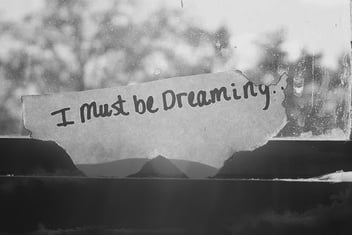An Intro to Lucid Dreaming
Ever since I can remember, dreams have always been a big part of my life. I’ve kept dream journals on and off since I was a kid, and going back and reading them is one of my favorite pastimes. One variant of dreaming that has always fascinated me is lucid dreaming. Lucid dreaming is the act of becoming conscious of the fact you are dreaming, and thus are able to control your dreams (to varying extents).
 Whenever I explain my interest in lucid dreaming to someone new, they tend to look at me as if I’m talking about some sort of mystical, magical nonsense. But there is researched, proven science behind lucid dreaming. It is a very real occurrence, and it's even been used for medical purposes, most commonly as a cure for chronic nightmares. And the best part about lucid dreaming is that if you’re dedicated (and willing to possibly lose some sleep), you can teach yourself to do it.
Whenever I explain my interest in lucid dreaming to someone new, they tend to look at me as if I’m talking about some sort of mystical, magical nonsense. But there is researched, proven science behind lucid dreaming. It is a very real occurrence, and it's even been used for medical purposes, most commonly as a cure for chronic nightmares. And the best part about lucid dreaming is that if you’re dedicated (and willing to possibly lose some sleep), you can teach yourself to do it.
There are a variety of methods you can use to teach yourself to lucid dream. I’ve recently taken Lawline's Actively Learning Core Value into practice and am starting to experiment with several of these methods. Here’s a breakdown of two of the most common approaches, in case you’re interested in starting to explore your own personal dream world:
Dream-Initiated Lucid Dreaming
Dream-initiated lucid dreaming takes conscious effort and dedication during your day-to-day life. The idea behind dream-initiated lucidity is to become conscious of your wakeful state throughout the day and tie it to some sort of stimuli that you will recognize in your dreams. (Think the totems in Inception, but a lot simpler.) For example, the method I’m using is drawing an ‘A’ on the palm of my hand. This A stands for ‘awake’, and every time I see the A, I become conscious of the fact I’m awake. Then I perform something called a wake-test (or a reality check), such as looking in a mirror to see if my reflection is normal. If my reflection is normal, I know that I am most likely awake. However, if my reflection were to appear distorted, or if it was missing completely (common occurrences in dreams), I would become aware of the fact that I’m dreaming and gain consciousness in my dream. I would then, theoretically, be able to control some aspects of my dream. If you get in the habit of performing these wake-te sts during your daily life, you are more likely to perform them in your dreams and become lucid.
sts during your daily life, you are more likely to perform them in your dreams and become lucid.
Wake-Initiated Lucid Dreaming
Wake-initiated lucid dreaming occurs when the dreamer goes directly into REM sleep (when lucid dreams take place) from a waking state without breaking self-awareness. This is a more difficult avenue into lucid dreaming, but with the help of a website called Square Eater, it’s easier than ever to achieve lucidity from a waking state. Square Eater provides a pairing of audio and visual stimuli that replicate the brain waves that occur during REM sleep. This helps the brain reach those wavelengths more rapidly, thus initiating REM sleep closer to the gap between sleep and wakefulness and allowing dreaming to happen while the person is closer to consciousness. This makes it much easier to become aware of when you're dreaming.
There are plenty of other methods that can help one learn to lucid dream. One very important step in learning to lucid dream is to keep a dream journal. Keeping a dream journal will help to recognize recurring events, objects, or symbols in your dreams. Once you becoming conscious of the recurring themes in your dreams, you are more likely to notice them in your dreams and realize that you are dreaming, which induces lucidity.
The ability to lucid dream doesn’t come overnight. But if you are dedicated, it’s very achievable. Experiment with it! The sooner you start, the sooner you will be experiencing your dreams like never before.

 Facebook
Facebook
.png) X (Twitter)
X (Twitter)
 LinkedIn
LinkedIn
